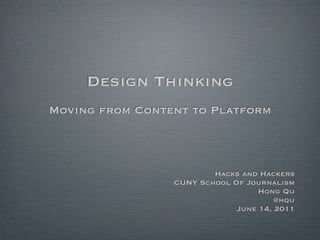
Content to Platform
- 1. Design Thinking Moving from Content to Platform Hacks and Hackers CUNY School Of Journalism Hong Qu @hqu June 14, 2011
- 2. Exercise 1 Please read: http://www.nytimes.com/2006/04/16/ arts/16carney.html
- 3. CONTENTS What is a platform? Design thinking User Centered Design User research Design process at YouTube Case Study: Knight site redesign What makes a good platform?
- 4. Exercise 2 Content Platform
- 5. CONTENT PLATFORM • information • tools • entertainment • interactive • stories • real-time • static • different roles • one directional passive consumer • audience engaged • broadcast model contributor ◦ one to many admin ◦ star to fan • production cost • consumption • peer to peer model • product cost many to many • producers are selected by expert • producers emerge base on metrics
- 6. USER CENTERED DESIGN Design Phase Analysis Phase Begin to brainstorm design concepts and metaphors Look at competitive products Develop screen flow and navigation model Create user profiles Do walkthroughs of design concepts Develop a task analysis Begin design with paper and pencil Document user scenarios Create low-fidelity prototypes Document user performance requirements Conduct usability testing on low-fidelity prototypes Create high-fidelity detailed design Deployment Phase Deployment Phase Use surveys to get user feedback Conduct field studies to get info about actual use Check objectives using usability testing USABILITY PROFESSIONALS ASSOCIATION UC BERKELEY UI DESIGN CLASS
- 7. YOUTUBE DESIGN PROCESS HTTP://WWW.NYTIMES.COM/2006/04/16/ARTS/ 16CARNEY.HTML HTTP://WWW.YOUTUBE.COM/WATCH?V=GCQZRNFCZUA HTTP://WWW.SLIDESHARE.NET/HONGQU/QUICKLIST-DESIGN-PROCESS
- 8. TOOLS & METHODS GOOGLE ANALYTICS METAPHOR BRAINSTORMING SILVERBACK APP QUORA OMNIGRAFFLE 5 SECOND TEST ETHNOGRAPHY CAFE STUDY (CONTEXTUAL INQUIRY) DIARY STUDY
- 10. RESOURCES Donʼt Make me Think UI Design Pattern Libraries Observing the User Experience Yahoo pattern library Elements of the User Experience Welie interaction patterns Designing for the Social Web Ideo Method Cards About Face 3 IxDA Ambient Findability UPA Sketching the User Experience Captology Design of Everyday Things HTTP://WWW.SLIDESHARE.NET/HONGQU/UX-TOOLS
- 11. Exercise 3 What do you want to get out of the visiting the Knight Foundation website?
- 12. JENNY’S FEEDBACK if i want to go to knight i want to sign up and follow via twitter/facebook/email i want to keep Informed in the space i am in whether community/news i think someone visiting should be like"knight knows what is going on. is plugged in” so i think it should be like maybe "this is what we are seeing"
- 13. KNIGHT SITE CASE STUDY Design Process Build Wireframe Interview users and stakeholders Site Map Competitive analysis User testing with wireframe User modeling Visual design Personals and scenarios Implementation Critical path for each user Type User testing with working prototype Task analysis Log traffic analysis Log traffic analysis
- 14. WHY PLATFORMS FAIL 1. Users are not aware of it 2. Users don’t understand how it works 3. Users are not motivated. Don’t care about achieving that goal.
- 15. SUMMARY Observer users Watch out for emergent behavior Ethnography Usability testing Metaphors Content analysis Competitive analysis Traffic log analysis Gain insight into their goals (Re)design features users want Diary study Paper prototype Personas Cafe tests Task analysis A/B and percentage tests
- 16. JAWED KARIM There were a number of iterations and very critical anticipated that people would use PayPal on eBay insights which were only possible due to real- —it’s something we had never thought of. world usage. Again, these insights are not ones you But then as it really kind of exploded, we saw, ‘Oh can gain inside the laboratory. wait, this is actually the best usage scenario, so we’re going to go support it’—you know, change For example, I remember at PayPal, initially it was our product in support of that pattern. a mobile payment service where you could beam money between cell phones. I think that attracted Same with YouTube. Initially, we did know that it —the total number of users was 5,000 ever, and it was going to be a video-sharing product, but it was shut down in early 2000 and we decided to go wasn’t clear in what space it was going to be. So with the Web site instead. And, of course, the way initially, it had more of a dating focus, which didn’t PayPal ended up succeeding was with that really end up being very popular, and then we had amazing synergy between PayPal and eBay. to expand the concept to make it more broad. That’s where PayPal really took off. But I remember the first instances when PayPal users were posting PayPal links on eBay, the reaction from PayPal business development was, ‘What the hell are these guys doing?’—like, ‘Close their accounts, we can’t have this!’ Because we had not HTTP://WWW.TCBMAG.COM/PEOPLECOMPANIES/PEOPLEANDCOMPANIES/106531P3.ASPX
- 17. Thanks you! Let’s have a Discussion Hacks and Hackers CUNY School Of Journalism Hong Qu @hqu June 14, 2011
Notas del editor
- \n
- \n
- \n
- \n
- \n
- \n
- \n
- \n
- \n
- \n
- \n
- \n
- \n
- \n
- \n
- \n
- \n